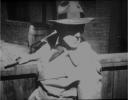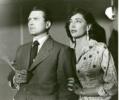The Narrow Margin (1952) Richard Fleischer | writ. Earl Felton [story by Martin Goldsmith & Jack Leonard] | cine. George E. Diskant | art. Albert S. D'Agostino & Jack Okey | edt. Robert Swink | sound. Francis Sarver & Clem Portman
 star. Charles McGraw (Det. Brown) Marie Windsor (Mrs.
Neall/ Sarah Meggs) Jacqueline White (Mrs. Sinclair/ Mrs. Neal) Gordon Gebert
(Tommy), Queenie Leonard, David Clarke (Joseph Kemp), Peter Virgo (Denzel), Don
Beddoe (Det. Forbes), Paul Maxy (Jennings), Peter Brocco (Vincent Yost), Harry
Harvey
star. Charles McGraw (Det. Brown) Marie Windsor (Mrs.
Neall/ Sarah Meggs) Jacqueline White (Mrs. Sinclair/ Mrs. Neal) Gordon Gebert
(Tommy), Queenie Leonard, David Clarke (Joseph Kemp), Peter Virgo (Denzel), Don
Beddoe (Det. Forbes), Paul Maxy (Jennings), Peter Brocco (Vincent Yost), Harry
Harvey
RKO Pictures 70 mins 1952
just a job, and no joy in it
|| As the credits roll: the intercontinental pulls into Chicago at night, and two detectives, Brown (Charles McGraw) and Forbes (Don Beddoe) disembark. Forbes is older, plump, wears a dark overcoat, smokes a cigar. Brown... masculine tough, fedora, trenchcoat, chain smokes cigarettes. No sooner are their suitcases on the platform than Brown shows the conductor a return ticket, instructs him to have the cases re-boarded as he and his partner will return within the hour to take the train back to L.A.
Why the quick visit? The widow of the Chicago gangster Frank Neall has a list of names that she has agreed to turn over to the Grand Jury looking into organized crime in Los Angeles. Brown & Forbes have been sent by the D.A. in order to ensure a safe passage for Mrs. Neall back to L.A. When they get to the apartment where she's being held in protective custody, she's chain-smoking and listening to dance music on a small windup phonograph. She certainly looks the part: an aggressive full-figured gangster's moll, "a 60 cent special", a cheap date who was probably a rent-a-dance girl before marrying dirty money. As they exit the apartment they are ambushed on the stairs by a hood wearing a de rigueur Prohibition overcoat with a fur-collar. The hit is bungled, although Forbes is killed and the assassin escapes over a back-yard fence into an alley where a getaway car is waiting.
While this action might seem generic for the genre, the expressionist cinematography is the best of its kind. You want noir shadows? Check out how the stair-rail bars ripple shadows over the ascending cops, the chiaroscuro poetry between light and darkness. The set is angular & tight, like a comic strip frame... and establishes the medium shot/close-up photography that dominates the train sequences and makes all the characters large and intimate.
It's a bad start for Det. Brown. He's lost his partner, and his consort is a yappy self-centred bitch who's always in his face. This "Mrs. Neall" is a party doll who hyper-spaces between paranoia and flirtation as easy as igniting a match. She fills a stereotype and all your expectations. Brown would have an easier time concealing a horse on the train... yet through a series of amusing antics he manages well enough until they are almost in L.A. He also manages to romance a certain blonde called "Mrs. Sinclair" who is travelling with her young son and a nanny. For a man whose partner was just shot by the mob, and who have him marked as the bodyguard of the witness, he does o.k.

deception, reflection, and the art of revelation
This film is all about style: the way it looks, the cine, the editing, the sets, the costumes, the attitude. The use of optical reflection is taken to a dramatic and aesthetic extreme, becomes the signature of the action, more so than the plot. "Reflection" ties directly into the theme as well as being an accurate visual dynamic of train travel. Nothing is what it seems, especially with certain key characters, who reverse identities with Aristotelian precision [i.e. Marie Windsor & Jacqueline White]. Like a double or triple exposure, the imagery in the windows contains layers, dimensions, motivations, premonitions. You know how it is on the night train as you relax with a scotch & soda in the club car, spying casually on the other patrons via the reflections in the window... reflections which inter-weave with the shadowy rushing landscape outside... the subtle blend of the past & present tenses, of memory and the evolving status quo. It's through the use of reflection, in fact, that the resolution of the story is achieved when Det. Brown does some fancy shooting.
Yet there's nothing intellectual about The Narrow Margin, despite the geometric precision of the cinematography and the editing. The montage conceals the simplicity of the characters and their business. Mrs. "Sinclair" is a bourgeois fix, a charming victim who dismisses her complicity in crime by saying, "Who knows what kind of woman marries a gangster?" Suspension of disbelief is required at least twice here: one, that no one in the syndicate knows what Frankie Neall's wife looks like, and two, that the widow needs to courier a list of names to L.A. when the U.S. mail would do just nicely. True, she needs to testify before the Grand Jury... but the "list" could've been delivered separately. The Marie Windsor character's deception of her colleague Det. Brown is a thing of beauty, yet seems improbable, unless the real mission is to test his loyalty.

Her volatile character is played to perfection by Marie Windsor, the former Vargas model and beauty queen, who played many noir tramps and vamps such as this one or her corrosive whipper role in the great Kubrick racetrack heist film The Killing. The recent DVD of The Narrow Margin contains the now obligatory commentary version -- in this instance by the accomplished Hollywood director William Friedkin who more or less declares himself to be an understudy of Richard Fleischer in terms of technique, especially on how "to move the action." Friedkin draws parallels to his famous New York-Marseilles drug movie The French Connection (1971)... and you can also see a similar narrative drive in his To Live & Die In L.A. (1985).
Narrative semiotics aside, Friedkin's commentary is outstanding, both as an insider's view and for its positioning of The Narrow Margin within the history of film noir. Who, for example, can dispute his observation that there's a missing scene/sequence at the end? To deal with Marie Windsor's character? It is so. Aesthetics & propaganda demand it.
Despite the hard-boiled characters and the grim action, most of it is strictly theatre. The closed space of the train is theatre. The burlesque entrances and exits are theatre. Ducking into washrooms, wrong compartments, alcoves... all this is theatre. The character tableaux is theatre. The gangster's moll, the fat man railway cop, Denzel the Prohibition assassin, Brown in a trenchcoat... in the reductive universe, it's almost paint by numbers.
Yet withal the realism is impressive. As Friedkin observes, Brown's fight with Kemp in the washroom compartment is seminal, was copied in the James Bond movie From Russia With Love. It was also copied by Ken Annakin in Across the Bridge (1957) when Rod Steiger needs to kill and assume the identity of another man. Claustrophobic and real, shot with a hand-held camera. It's also one of the longest scenes in the film, almost 4 minutes if you include the fight and its aftermath interrogation. All the while the sense of being in a speeding train is sustained by the strobing light & pulsing shadow lines typical of the experience... and of course the rolling vertigenous sound of the train.
You could call The Narrow Margin pseudo "neo-realism" because it affects a documentary naturalism by using no music, and by simulating ambient sound. The sound of train -- within and without -- with its machine rhythm and doppler transitions is worthy of musique concrete. The train sets, too, are so realistic, so authentic in detail, that you assume all sequences are filmed on location.
© LR 3/06